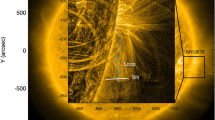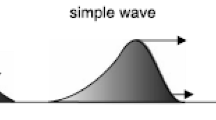Abstract
Magnetic field in the solar lower atmosphere can be measured by the use of the Zeeman and Hanle effects. By contrast, the coronal magnetic field well above the solar surface, which directly controls various eruptive phenomena, can not be precisely measured with the traditional techniques. Several attempts are being made to probe the coronal magnetic field, such as force-free extrapolation based on the photospheric magnetograms, gyroresonance radio emissions, and coronal seismology based on MHD waves in the corona. Compared to the waves trapped in the localized coronal loops, EIT waves are the only global-scale wave phenomenon, and thus are the ideal tool for the coronal global seismology. In this paper, we review the observations and modelings of EIT waves, and illustrate how they can be applied to probe the global magnetic field in the corona.
Similar content being viewed by others
References
Sahal-Bréchot S. The Hanle effect applied to magnetic field diagnostics. Space Sci Rev, 1981, 29: 391–401
White S M. Solar and Space Weather Radiophysics, Vol. 314. In: Gary D E, Keller C U, eds. Dordrecht: Academic Publisher, 2004. 89–113
Roberts B, Edwin P M, Benz A O. On coronal oscillations. Astrophys J, 1984, 279: 857–865
Moreton G E, Ramsey H E. Recent observations of dynamical phenomena associated with solar flares. Publ Astron Soc Pac, 1960, 72: 357
Uchida Y. Propagation of hydromagnetic disturbances in the solar corona and Moreton’s wave phenomenon. Sol Phys, 1968, 4: 30–44
Roberts B. Waves and oscillations in the corona. Sol Phys, 2000, 193: 139–152
Thompson B J, Plunkett S P, Gurman J B, et al. SOHO/EIT observations of an Earth-directed coronal mass ejection on May 12, 1997. Geophys Res Lett, 1998, 25: 2465–2468
Vršnak B, Warmuth A, Temmer M, et al. Multi-wavelength study of coronal waves associated with the CME-flare event of 3 November 2003. Astron Astrophys, 2006, 448: 739–752
Thompson B J, Gurman J B, Neupert W M, et al. SOHO/EIT observations of the 1997 April 7 coronal transient: Possible evidence of coronal moreton waves. Astrophys J, 1999, 517: 151–154
Chen P F. Initiation and propagation of CMEs. J Astrophys Astron, 2008, 29: 179–186
Wills-Davey M J, Thompson B J. Observations of a propagating disturbance in TRACE. Sol Phys, 1999, 190: 467–483
Chen P F, Fang C. EIT waves — A signature of global magnetic restructuring in CMEs. IAU Symp, 2005, 226: 55–64
Klassen A, Aurass H, Mann G, et al. Catalogue of the 1997 SOHO-EIT coronal transient waves and associated type II radio burst spectra. Astron Astrophys, 2000, 141: 357–369
Thompson B J, Myers D C. Catalog of coronal “EIT Wave” transients. Astrophys J Suppl Ser, 2009, 183: 225–243
Long D M, Gallagher P T, McAteer R T J, et al. The kinematics of a globally propagating disturbance in the solar corona. Astrophys J, 2008, 680: L81–L84
Wu S T, Zheng H, Wang S, et al. 3D numerical simulation of MHD waves observed by EIT. J Geophys Res, 2001, 106: 25089–25102
Wang Y M. EIT waves and fast-mode propagation in the solar corona. Astrophys J, 2000, 543: L89–L92
Grechnev V V, Uralov A M, Slemzin V A, et al. Absorption phenomena and a probable blast wave in the 13 July 2004 eruptive event. Sol Phys, 2008, 253: 263–290
Veronig A M, Temmer M, Vršnak B. High-cadence observations of a global coronal Wave by STEREO EUVI. Astrophys J, 2008, 681: L113–L116
Delannée C, Aulanier G. CME Associated with transequatorial loops and a bald patch flare. Sol Phys, 1999, 190: 107–129
Chen P F, Wu S T, Shibata K, et al. Evidence of EIT and Moreton waves in numerical simulations. Astrophys J, 2002, 572: L99–L102
Chen P F, Fang C, Shibata K. A full view of EIT waves. Astrophys J, 2005, 622: 1202–1210
Harra L K, Sterling A C. Imaging and spectroscopic investigations of a solar coronal wave. Astrophys J, 2003, 587: 429–438
Warmuth A, Mann G. A model of the Alfvén speed in the solar corona. Astron Astrophys, 2005, 435: 1123–1135
Author information
Authors and Affiliations
Corresponding author
Additional information
Supported by the National Basic Research Program of China (Grant No. 2006CB806302) and the National Natural Science Foundation of China (Grant Nos. 10933003 and 10403003)
Rights and permissions
About this article
Cite this article
Chen, P. EIT waves and coronal magnetic field diagnostics. Sci. China Ser. G-Phys. Mech. Astron. 52, 1785–1789 (2009). https://doi.org/10.1007/s11433-009-0240-9
Received:
Accepted:
Published:
Issue Date:
DOI: https://doi.org/10.1007/s11433-009-0240-9




